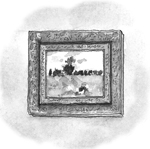

I visited the Musée d’Orsay in Paris on the same momentous return trip where I had the epiphany in Notre-Dame Cathedral which I wrote about earlier in this collection. Both of those pieces were the product of a lesson that was just beginning to crystallize for me: the importance of focus. The closer you focus on a place or a thing, the more you notice, and the more you have to say. When I began this essay, I wanted to write about the extraordinary richness of art in Paris, and how that richness added layers to the life of the city and to my interaction with that life. I first tried to write about three museums, but in my 750-word Examiner column, I could barely begin to say anything about each museum. Then I tried one museum, then one gallery in one museum, then five paintings in that gallery. Each time, the essay seemed too superficial, just glancing the surface of the topic. Finally I realized that the only way to do this topic justice would be to focus deeply on one painting and re-create my interaction with that painting. And that’s what I tried to do in this essay. After it was published, an art professor at San Francisco State University wrote to me that she was making it required reading in all of her courses—so perhaps I did something right!
![]()
I HAVE BEEN LOOKING AT MONET’S Les Coquelicots, the painting of two women and children walking through a field of bright red poppies on a sunny, cloud-dappled day, for about forty minutes. It moves me just as profoundly now as it did when I was last in Paris twelve years before; it still tugs deep within me, cuts through all the layers to something fresh and fundamental and childlike.
At first I stared at it closely, my nose within a foot of the canvas, so close that I could see the black-dot eyes of the child in the foreground—something I had never seen before, or at least never remembered seeing.
Get that close and you reduce the painting to its elements: layers of oil paint on canvas, brushstrokes, dabs, tiny tip-tips with the brush. You realize just how fragile a thing a painting is, and just how common.
And you realize too that it was made by a man—fragile, common—who stood at the canvas and thought: “a little more red here,” dab, dab; “a cloud there,” push, push; “how can I capture that light?”
Look at the painting closely this way for a few minutes and you break it down into an intricate complexity of colors and textures and forms.
Then step back and—voilà!—all of a sudden it is a composed whole, a painting: a cloud-bright sky and poppy-bright field, a woman with a fancy hat and a parasol and a child almost hidden by the tall grasses in the foreground, and in the background another woman and a child almost obscured against a distant stand of trees. They are on a walk, or a picnic—a story begins to compose itself, to take on a life inside and outside the canvas.
And you realize that this is a kind of miracle, that colors and shapes dabbed on a piece of cloth 115 years ago have somehow reached across time and culture to touch you.
Look long enough and feel deeply enough, and your eyes fill with tears.
And when you feel these wet, cool, unexpected tears, you look around you suddenly as if waking from a dream, and see men and women in shorts, blue jeans, dresses, and sportcoats, holding guidebooks and pointing at the canvas and sighing, or whispering in passionate appreciation.
You feel strangely displaced—for a moment it was your painting, or rather, you were a part of it, and now you are outside it again—but then you think, “This too is part of the miracle, that one painting can touch so many people.”
You think of art’s extraordinary power, that a scattering of people and poppies in a field can push age, despair, fatigue, and cynicism away, can focus you so intensely on this time, this place; that time, that place.
You stand close to the canvas again and see the complexity of colors—the fields all gray, brown, green, yellow-green; the poppies red and pink; the sky a mixture of light and dark blues; the clouds gray, purple, white.
You see that the forms are simple: a gently rolling landscape; smoothly, sparingly suggested people. And that the child in the foreground holds flowers that are almost the same color as the band in his (her?) hat.
You step back one last time and see peace, lightness, a sense of infinite wonder and potential, a childlike purity.
And when you return to the luminous streets you know you will hold that vision in your head, like a handful of flowers on a country-bright day.
You know that you have returned to Paris. You know that, deep inside, you were never away.
![]()